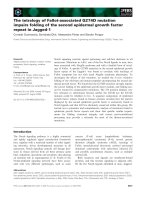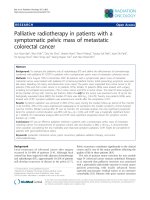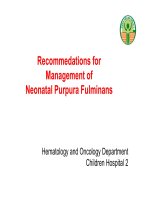Symptomatic neonatal tetralogy of Fallot K
Bạn đang xem bản rút gọn của tài liệu. Xem và tải ngay bản đầy đủ của tài liệu tại đây (108.96 KB, 20 trang )
Symptomatic neonatal
tetralogy of Fallot:
repair or shunt ?
Definition
• Lesions occurs in 3 of every 10,000 live births, and
accounts for 7–10% of all congenital cardiac
malformations.
Anatomic Features
1) RVOT obstruction (infundibular stenosis)
2) VSD
3) Aorta dextroposition, overrides VSD
4) RV hypertrophy
The VSD and infundibular stenosis determine the
pathophysiologic features
Definition
Controversy
• Some centres will perform complete
repairs in all neonates. Others will palliate
symptomatic neonates, and perform a
complete repair in all patients at the age of
4 to 6 months.
Complete neonatal repair( adv)
• Prompt relief of the volume and pressure
overload on the right ventricle,
• Minimises cyanosis, decreases parental
anxiety, and eliminates the theoretical risk
of stenosis occurring in a pulmonary artery
due to a palliative procedure
•
Frederique Bailliard, Robert H Anderson. ReviewTetralogy of Fallot.
Orphanet Journal of Rare Diseases 2009, 4:2
Complete neonatal repair( adv)
• Early repair, providing adequate
pulmonary blood flow, with homogeneous
distribution to both lungs, allows normal
growth and development of the pulmonary
arteries.
• This is an advantage considering the
potential negative effects on the
pulmonary arteries of a systemic-topulmonary shunt.
Complete neonatal repair( adv)
• Patients who undergo a successful
complete repair during the neonatal period
will be unlikely to require more than one
intervention in the first year of life, but are
not free from reintervention.
Complete neonatal repair( disadv)
• Shunting or primary repair of neonates
with symptomatic TOF provides equivalent
mortality and results.
• The primary repair patients more
frequently had a transannular patch and a
tendency to more frequent delayed sternal
closure .
Complete neonatal repair( disadv)
• Shunted patients had fewer transannular patch
repairs despite having more emergent initial
operations.
• Compared with the primary repair group,
shunted patients had decreased intensive care
unit and hospital stays for the first
hospitalization, which were neutralized when the
second operation (repair) values were added.
•
Kanter KR, Kogon BE, Kirshbom PM, Carlock PR. Symptomatic neonatal
tetralogy of Fallot: repair or shunt? Ann Thorac Surg. 2010 Mar;89(3):85863.
Complete neonatal repair( disadv)
• Neonatal complete repairs include
exposure of the neonatal brain to
cardiopulmonary bypass, and the
increased need to place a patch across
the ventriculo-pulmonary junction when
compared to older age at repair
•
•
Hirsch J, Mosca R, Bove E: Complete repair of tetralogy of Fallot in the
neonate. Annals of Surgery 2000, 232(4):508-514. 25.
Stewart RD, Backer CL, Young L, Mavroudis C: Tetralogy of Fallot: Results
of a pulmonary valve-sparing strategy. Annals of Thoracic Surgery 2005,
80:1431-1439
Complete neonatal repair( disadv)
• Transannular patches, create a state of chronic
pulmonary regurgitation, which increases
morbidity in young adults, producing exercise
intolerance and ventricular arrhythmias.If left
untreated, this increases the risk of sudden
death
•
•
•
Nollert G, Fischlein T, Bouterwek S, Böhmer C, Klinner W, Reichart B: Long-term
survival in patients with repair of TOF: 36-year follow-up of 490 survivors of the first
year after surgical repair. The Journal of the American College of Cardiology 1997,
30:1374-1383.
Helbing WA, Roest AA, Niezen RA, Vliegen HW, Hazekamp MG, Ottenkamp J, de
Roos A, Wall EE van der: ECG predictors of ventricular arrhythmias and biventricular
size and wall mass in tetralogy of Fallot with pulmonary regurgitation. Heart 2002,
88:515-520.
Gatzoulis MA, Till JA, Somerville J, Redington AN: Mechanoelectrical interaction in
tetralogy of Fallot, QRS prolongation relates to right ventricular size and predicts
malignant ventricular arrhythmias and sudden death. Circulation 1995, 92(2):231-237.
Complete neonatal repair( disadv)
• The effect of cardiopulmonary bypass on the
neonatal brain, and the associated risk of longer
stay in hospital and the intensive care unit, is not
trivial.
• Studies of neurodevelopmental outcomes of
neonates undergoing cardiopulmonary bypass
compared to older children have shown lower
intelligence quotients in patients exposed to
bypass as neonates
•
Miller G, Tesman JR, Ramer JC, Baylen BG, Myers JL: Outcome after
open-heart surgery in infants and children. Journal of Child Neurology 1996,
11(1):49-53
Complete neonatal repair( disadv)
• Longer periods of bypass, and longer
stays in the intensive care unit, have been
associated with an increased risk for
neurological events and abnormal
neurological findings on followup
•
•
Limperopoulos C, Majnemer A, Shevell MI, Rohlicek C, Rosenblatt B,
Tchervenkov C, Darwish HZ: Predictors of developmental disabilities after
open heart surgery in young children with congenital heart defects. The
Journal of Pediatrics 2002, 141(1):52-58.
Fallon P, Aparício JM, Elliott MJ, Kirkham FJ: Incidence of neurological
complications of surgery for congenital heart disease. Archives of Disease
in Childhood 1995, 72:418-422
Complete neonatal repair( disadv)
• While some studies have not found
cyanosis itself to be responsible for
cognitive problems in children with
congenitally malformed hearts
•
Wright M, Nolan T: Impact of cyanotic heart disease on school performance.
Archives of Disease in Children 1994, 71:64-70.
Complete neonatal repair( disadv)
• Others have implicated chronic cyanosis
as a factor contributing to impaired motor
skills, decreased academic achievement,
and worsened behavioural outcomes
•
•
Stieh J, Kramer HH, Harding P, Fischer G: Gross and fine motor
development is impaired in children with cyanotic congenital heart disease.
Neuropediatrics 1999, 30(2):77-82.
Bass JL, Corwin M, Gozal D, Moore C, Nishida H, Parker S, Schonwald A,
Wilker RE, Stehle S, Kinane TB: The effect of chronic or intermittent
hypoxia on cognition in childhood: a review of the evidence. Pediatrics
2004, 114:805-816.
Difficulty
• In the absence of randomised control
trials, assessing the risk and benefits of
the two surgical strategies has been
notoriously difficult
Summary
• Patients with cyanotic tetralogy of Fallot will
either undergo neonatal complete repair or
neonatal palliation with an aortopulmonary shunt
followed by a complete repair at four to six
months of age.
• Peri-operative mortality rates for either surgical
approach is less than 3% and since neither
strategy has shown superior results, surgical
management remains dependent on the
protocols preferred by the individual centres.
Summary
• In any case the potential advantages of a
primary early repair should be weighted
against the experience and expertise of
the individual centre and/or surgical team
in dealing with tetralogy of Fallot and with
neonates and infants
Questions
• Questions that remain regarding the
management of tetralogy of Fallot pertain
to the preference of surgical timing,as
discussed above, and to the residual
lesions of the disease.
• The management of young adults with
pulmonary regurgitation or residual
pulmonary stenosis is complex
Answers
• Recent advances in interventional cardiac
catheterisation now provide safe options for
treatment other than cardiac surgery
•
•
Lurz P, Coats L, Khambadkone S, Nordmeyer J, Boudjemline Y, Schievano
S, Muthurangu V, Lee TY, Parenzan G, Derrick G, Cullen S, Walker F,
Tsang V, Deanfield J, Taylor AM, Bonhoeffer P: Percutaneous pulmonary
valve implantation. Impact of evolving technology and learning curve on
clinical outcome. Circulation 2008, 117:1964-1972.
45. Frigiola A, Tsang V, Nordmeyer J, Lurz P, van Doorn C, Taylor AM,
Bonhoeffer P, de Leval M: Current approaches to pulmonary regurgitation.
European Journal of Cardiothoracic Surgery 2008, 34(3):576-580.









